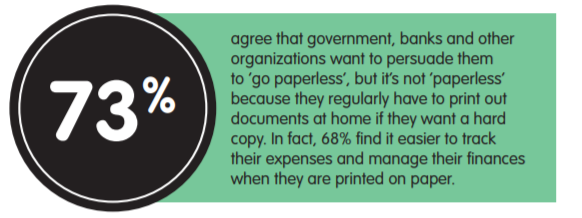Hard to imagine, but there are still a lot of companies out there spreading the “greenwashing” myth.
“Environmentally-conscious consumers rely on corporate messages to inform their purchasing choices,” explains this article in Two Sides NA. “Yet, it is not uncommon for organizations to make misleading environmental claims that promote switching from paper to electronic services as better for the environment, i.e. ‘go paperless – go green’ and ‘save trees.’”
The problem came to a head over the past couple of years, with growing awareness of the true cost of the digital footprint emerged. At the same time, the paper industry started doing a better job informing consumers about sustainable paper production and its positive impact on the environment. It’s pretty clear that going paperless won’t save the forests – but sustainable forestry and paper demand can increase the amount of forested land significantly.
It also fairly obvious that there’s huge consumer mistrust of greenwashing claims. It’s easier and cheaper in the short run for companies to send you digital invoices; that’s why they want you to switch to digital. Yet when given a choice, consumers strongly favor print for important communication, especially when it comes to their finances.

Even the government stepped in, warning companies to quit sending misleading emails aimed at getting customers to switch to digital bills. At the same time, many brands removed their anti-paper claims, pledging to be more upfront about their environmental marketing tactics.

In spite of all this, greenwashing is still a thing.
“The misleading aspects of most paperless marketing slogans also fail to meet the requirements of many published environmental guidelines and laws, such as the Green Guides of the U.S. Federal Trade Commission (FTC), the Competition Bureau of Canada, and the ISO14021 standard,” notes Two Sides NA. “All these publications specify that vague claims (such as ‘green’) should not be used and that claims must be specific and require substantiation based on recognized scientific methods.”
Apparently, not everyone got (or read) the memo.
Listen, I’m not saying brands should do this just because the government says so – although yeah, in general, compliance with recommendations like these is the way to go when you’re in a business that serves the public. I am saying that brands should be listening better to their customers. And consumers want choice.
“A survey conducted by Two Sides in 2017 found that 90% of U.S. consumers believe they should have the right to choose how they receive communications (printed or electronically) from their service providers,” Two Sides NA continues. “A further 83% believe they should not be charged more for choosing paper bills or statements and 57% would consider changing provider if forced to go digital-only. Equally, 72% agree that claims about the switch to digital being better for the environment are made because the sender wants to save money.”
In other words, they’re on to the scheme. They know it’s not really about the environment, but about the brands’ bottom lines. And that’s cool; brands are in business to make money. But don’t pull that green wool over your customers’ eyes anymore. The gig is up on greenwashing, and it’s time to be honest about it.
If you need some help making the switch in your own business, Two Sides NA offers some terrific ideas for doing so, like these Verizon campaign before and after shots that eliminate the green claims yet still give customers a choice (and maybe a good enough reason to switch to digital, or maybe not. The point is it’s truthful.)
It’s the era of trust. Don’t risk damaging your reputation with outdated claims that aren’t backed by facts. It’s time to come clean about green.
